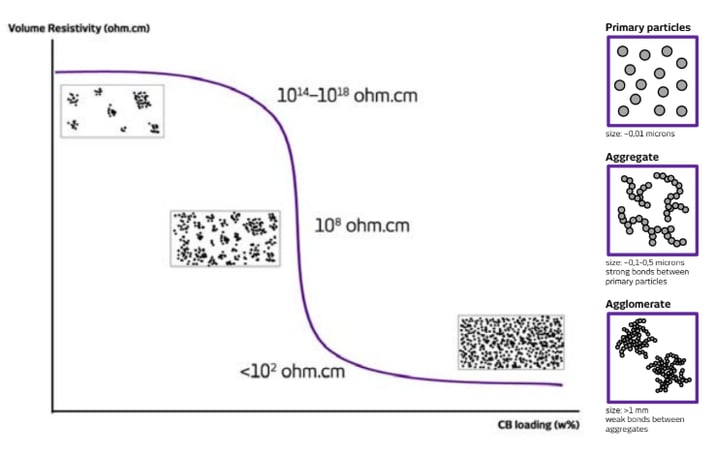Carbon black magic turning electrically conductive plastics into products
This post takes a look at the key element of conductive compounds – carbon black – and how it is used for creating the perfect compound mix.

Carbon black magic
Conductive carbon black is the most reliable and cost-efficient choice for producing electrically conductive plastic compounds. The secret behind the perfect carbon black compound lies in three important factors:
- Selecting the optimal carbon black type for the purpose
- Formulating the compound
- Optimizing the compounding technique
Electrically conductive plastics are used in countless processing methods and final applications. The role of the compounder is to ensure that the above-mentioned factors are executed correctly and to help the customer take full advantage of the compound in the manufacturing process. Together, these measures guarantee that the desired goals for the end products are met successfully.
Step 1 — Selecting the right carbon black
Carbon black comes in many varieties. The carbon black that works perfectly in truck tires is not the right choice for conductive compounds. Selecting the carbon black with just the right features is the first important step towards a successful end product. The most important factor affecting the electrical performance of carbon black is its structure. Particle size and porosity also have an impact on the electrical behavior of the electrically conductive compound.

Factors that improve electrical conductivity:
- High structure: the carbon black agglomerates form long and branched chains. Such a structure is ideal for conductive compounds – the required conductivity can be reached with lower loading levels.
- Small particle size: higher electrical conductivity. If the particles are small and relatively uniform in shape, their surface area is larger than otherwise. Extra conductive carbon blacks, with the smallest particle size, provide the highest electrical conductivity.
- High porosity: enables better electrical conductivity.
Step 2 — Formulating the right mix
After exceeding a certain loading level, carbon black changes the electrically insulating base polymer into electrically conductive plastic. The decrease in electrical volume resistivity due to the increased amount of carbon black can be described using a percolation model. The percolation behavior of carbon black depends on the qualities mentioned in step 1: particle size, structure, and porosity.
Premix’s R&D specialists can select just the optimum carbon black load needed to achieve the required electrical properties. Finding the correct loading level is extremely important: too high a carbon black load has a negative impact on the compound’s mechanical properties. It also increases viscosity, causing problems in the injection molding process, for example.
The percolation curve illustrates the relationship between the quantity of added carbon black (CB load) and the achieved electrical resistivity. Note the narrow threshold in which the electrical resistivity dramatically drops. After this threshold level, increasing carbon black will no longer improve the electrical properties.

Choosing the right carbon black also depends on how the material will be processed. Usually, the steepest part of the curve hits the static dissipative resistance levels (106–109 ohms). This makes the development and production of dissipative carbon black compounds very challenging. The carbon black content and the production process require careful control and monitoring.
Choosing the right carbon black also depends on how the material will be processed. For example, during the injection molding process, the compound is subjected to different processing conditions than during the extrusion process.
For each process, roughly speaking, there is a matching type of carbon black. Premix has accumulated 30 years of expertise in formulating and manufacturing electrically conductive compounds.
Based on our research, experience, and years of product development, we have found the perfect mix for any requirement.
Step 3 — Optimized compounding process
The final piece of the puzzle for creating a perfect electrically conductive compound is finding the optimal technique for dispersing the carbon black to the base polymer. The Premix compounding lines have been optimized for the production of electrically conductive plastics. For each formulation and base polymer, our processing engineers select the right machinery with optimal screw geometry and granulation technology. Carefully defined processing parameters ensure that the shear forces and process temperatures are at the ideal level. In optimal conditions, the carbon black agglomerates are separated into aggregates which are then dispersed and distributed evenly within the compound. This is done without breaking the carbon black’s structure.
Continuous quality control throughout the process and seamless cooperation between the production and quality assurance departments are the final checkpoints on the way to the perfect outcome.

Pasi Seppälä
Product Manager - Conductive Plastics
M.Sc of polymer technology with an excellent balance of skepticism and understanding of polymer-related phenomena. It might not be a bad idea to contact him when in (technical) doubt.